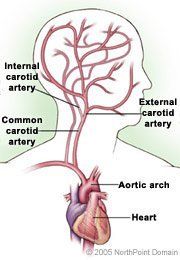Carotid Stenting
Basic Facts
- The buildup of atherosclerotic plaque in the carotid arteries can prevent blood from reaching parts of the brain, causing shortages of oxygen that can result in transient ischemic attack (TIA) or stroke. Clots can also form on narrowing arteries and break off, causing TIA or stroke.
- Stroke is the number one cause of permanent disability in the United States.
- A stent is a slender metal-mesh tube that can be placed inside an artery to keep the artery open and allow blood to flow past plaque blockages.
- Carotid stenting is a new treatment that offers an effective means of reestablishing blood flow through blocked carotid arteries, and is part of a stroke prevention strategy.

The two common carotid arteries bring oxygenated blood from the heart through the neck to each side of the head. As people age, plaque can build up inside their arteries. Blood clots forming on the plaque can cause an occlusion or blockage, preventing the flow of blood to the brain. The blockage can create an ischemia, or lack of oxygen caused by insufficient blood flow, which can cause an ischemic stroke if the blood flow is blocked long enough.
Carotid stenting is a procedure in which a tiny, slender metal-mesh tube is fitted inside a carotid artery to increase the flow of blood blocked by plaques. The stent is inserted following a procedure called angioplasty, in which the physician guides a balloon-tipped catheter into the blocked artery. The balloon is inflated and presses against the plaque, flattening it and re-opening the artery. The stent acts as scaffolding to prevent the artery from collapsing or being closed by plaque after the procedure is completed.
WHEN IS IT INDICATED?
Stenting is often recommended for people who are unable to undergo an endarterectomy. Endarterectomy, the surgical removal of plaque from the artery, is the standard treatment for severe buildup of plaque in the carotid artery. For some people, however, endarterectomy may not be appropriate. For example, the procedure is inappropriate for people who are unable to tolerate the side effects of anesthesia.
Common conditions that make endarterectomy high risk include:
- Advanced age or the presence of serious disease, such as cancer;
- Surgically inaccessible atherosclerotic plaques;
- Having undergone a previous endarterectomy;
- Having severe congestive heart failure or unstable angina; and/or
- Problems with other blood vessels in the head.
WHAT TO EXPECT
The goal of angioplasty is the restoration of adequate blood flow (revascularization) through the affected part of the body by enlarging the blood vessel from within.
To place a stent, the physician removes the angioplasty balloon catheter and inserts a new catheter on which a closed stent surrounds a deflated balloon. The stent-carrying catheter is advanced through the artery to the site of the blockage. The balloon is inflated, causing the stent to expand. The balloon is then deflated and the catheter withdrawn, leaving the stent in place. The stent in a carotid artery allows blood to flow to the brain.
The smooth lining of the arterial wall eventually grows back to cover the stent and secure it, so the stent will not dislodge. Stents are left in place permanently, and because they are made from stainless steel or metal alloys, they will not rust or deteriorate.
POSSIBLE COMPLICATIONS
Risks commonly associated with carotid stenting may include:
- Infection of the neck incision;
- Damage to nerves located near the carotid arteries;
- Slight risk of stroke because of a loose piece of plaque or a blood clot blocking an artery during or immediately following surgery;
- Abrupt closure of the artery after surgery;
- Restenosis (the reoccurrence of plaque buildup) that occurs after a stent has been placed in the carotid artery, preventing future endarterectomy; or
- Short periods of reduced blood pressure and heart rate that may occur, which is treated with medications.
Perhaps the most serious potential risk involved with carotid stenting is the risk of a disrupted plaque particle that breaks free from the site, called an embolism, and blocks an artery in the brain, causing a stroke. The risk is minimized using small filters called embolic protection devices in conjunction with angioplasty and stenting.
Hyperperfusion, or the sudden increased blood flow through a previously blocked carotid artery and into the arteries of the brain, may occur after stenting, and can cause a hemorrhagic stroke. While this is a risk of stenting, it is more likely to occur because of more invasive surgical procedures.
Copyright © 2017 NorthPoint Domain, Inc. All rights reserved.
This material cannot be reproduced in digital or printed form without the express consent of NorthPoint Domain, Inc. Unauthorized copying or distribution of NorthPoint Domain's Content is an infringement of the copyright holder's rights.
